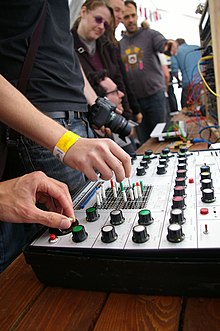EMS Synthi A: Difference between revisions
m Added technical info on the Patch Pins |
Corrected some grammar, syntax and spelling. Still needs work, though. |
||
| Line 2: | Line 2: | ||
[[Image:SynthiAKSStack.jpg|thumb|EMS SynthiA (top) as used on stage by a [[progressive rock]] band; underneath are a EMS DK keyboard controller, [[ARP String Ensemble|Solina String Ensemble]], [[Optigan]], and an M400 [[Mellotron]]]] |
[[Image:SynthiAKSStack.jpg|thumb|EMS SynthiA (top) as used on stage by a [[progressive rock]] band; underneath are a EMS DK keyboard controller, [[ARP String Ensemble|Solina String Ensemble]], [[Optigan]], and an M400 [[Mellotron]]]] |
||
The '''EMS Synthi A''' was a portable [[analog synthesizer]] ([[electronics|electronic]] [[musical instrument]]) made by [[Electronic Music Studios (London) Ltd]] (EMS) in 1971. |
The '''EMS Synthi A''' was a portable [[analog synthesizer]] ([[electronics|electronic]] [[musical instrument]]) made by [[Electronic Music Studios (London) Ltd]] (EMS) in 1971. |
||
It uses exactly the same electronics as the [[VCS 3]], rehoused in a Spartanite briefcase. Instead of routing signals using [[patch cable]]s, as a [[Moog synthesizer|Moog]] did, it uses a patch matrix with resistive pins. The 2700 ohm |
It uses exactly the same electronics as the [[VCS 3]], rehoused in a Spartanite briefcase. Instead of routing signals using [[patch cable]]s, as a [[Moog synthesizer|Moog]] did, it uses a patch matrix with resistive pins. The 2700 ohm resistors soldered inside the pin vary in tolerance 5% variance and later 1%; the pins have different colours: the 'red' pins have 1% tolerance and the 'white' have 5% while the 'green' pins are attenuating pins having a resistance of 68,000 ohms. |
||
The later Synthi AKS incorporated an early digital 256 event KS (Keyboard Sequencer) [[Music sequencer|sequencer]] in the lid, input provided by a capacitance sensitive [[Buchla]] like keyboard . |
The later Synthi AKS incorporated an early digital 256 event KS (Keyboard Sequencer) [[Music sequencer|sequencer]] in the lid, input provided by a capacitance sensitive [[Buchla]] like keyboard . |
||
Perhaps its most prominent use is in [[Pink Floyd]]'s "[[On the Run (Pink Floyd song)|On the Run]]" from their 1973 album ''[[The Dark Side of the Moon]]''. Along with [[Klaus Schulze]] and [[Tangerine Dream]] other frequent users of the instrument include [[Richard Pinhas]] of [[Heldon]], [[Merzbow]] and [[Alva Noto]]. |
Perhaps its most prominent use is in [[Pink Floyd]]'s "[[On the Run (Pink Floyd song)|On the Run]]" from their 1973 album ''[[The Dark Side of the Moon]]''. Along with [[Klaus Schulze]] and [[Tangerine Dream]], other frequent users of the instrument include [[Richard Pinhas]] of [[Heldon]], [[Merzbow]] and [[Alva Noto]]. |
||
The Synthi A is still in production but it is an 18 |
The Synthi A is still in production but it is an 18-month wait for a new unit with slightly different specifications to those of the original 1970's units. All versions are rare and expensive. Cost for a new unit in 2009 ranged between $7500 and $12,000 US. A KS sequencer alone sold for $3500 in 2006. |
||
[[Image:EMS Synthi A.jpg|thumb|EMS Synthi A]] |
[[Image:EMS Synthi A.jpg|thumb|EMS Synthi A]] |
||
Revision as of 07:38, 1 April 2012
This article includes a list of references, related reading, or external links, but its sources remain unclear because it lacks inline citations. (August 2009) |

The EMS Synthi A was a portable analog synthesizer (electronic musical instrument) made by Electronic Music Studios (London) Ltd (EMS) in 1971. It uses exactly the same electronics as the VCS 3, rehoused in a Spartanite briefcase. Instead of routing signals using patch cables, as a Moog did, it uses a patch matrix with resistive pins. The 2700 ohm resistors soldered inside the pin vary in tolerance 5% variance and later 1%; the pins have different colours: the 'red' pins have 1% tolerance and the 'white' have 5% while the 'green' pins are attenuating pins having a resistance of 68,000 ohms.
The later Synthi AKS incorporated an early digital 256 event KS (Keyboard Sequencer) sequencer in the lid, input provided by a capacitance sensitive Buchla like keyboard .
Perhaps its most prominent use is in Pink Floyd's "On the Run" from their 1973 album The Dark Side of the Moon. Along with Klaus Schulze and Tangerine Dream, other frequent users of the instrument include Richard Pinhas of Heldon, Merzbow and Alva Noto.
The Synthi A is still in production but it is an 18-month wait for a new unit with slightly different specifications to those of the original 1970's units. All versions are rare and expensive. Cost for a new unit in 2009 ranged between $7500 and $12,000 US. A KS sequencer alone sold for $3500 in 2006.

